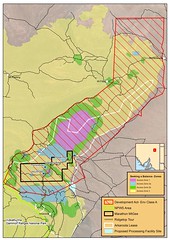 The map at left, courtesy of The Wilderness Society, superimposes the Class A Environmental Zone created by the 2003 Development Plan for the Flinders Ranges (or Class A for short) over the recently released 'Seeking a Balance - conservation and resource use in the Northern Flinders Ranges' (SaB) document's proposed mineral access zoning.
The map at left, courtesy of The Wilderness Society, superimposes the Class A Environmental Zone created by the 2003 Development Plan for the Flinders Ranges (or Class A for short) over the recently released 'Seeking a Balance - conservation and resource use in the Northern Flinders Ranges' (SaB) document's proposed mineral access zoning.
(Click the image to go to the flickr page where it's possible to access large - and very large - versions of this map.)
To quote 'Seeking a Balance' itself
'much of the Northern Flinders Ranges lies within the Development Plan’s Environmental Class A Zone. The prime objectives of the Environmental Class A Zone seek to conserve the natural character and environment of the area and to protect the landscape from damage by mining operations and exploring for new resources.
In the map the
Class A Zone is indicated by the large red hatched area. Under the existing Class A provisions mining is currently possible within it only if the deposit is of 'paramount importance' and in 'the national interest' and if no similar resource is available outside the zone. Any proposed 'infrastructure' is limited to walkers huts and associated rainwater tanks and the like.
'Seeking a Balance' excludes mining and associated infrastructure only in the
Purple Zones (Zone 1 in SaB). While this is an excellent result in the case of the
Mawson Plateau, the largest such area, the story for the rest of the northern Flinders is rather different, and particularly for the disputed area of Exploration Lease 4355, which is shown outlined in black (see detail map below).
Roughly,
Blue Zones (SaB Access Zone 2a) allow for restricted, 'non-disturbing' exploration activity and potential mining access only from 'outside' those zones (i.e from underground.) Any activity must be jointly-approved by both the Dept for Mineral Resources and the Dept for Environment.

But please bear in mind, within controversial uranium exploration lease EL 4355 - the black outline - the exploration drilling around Mount Gee and Mount Painter has largely been done already in or adjacent to these sectors. Since these zones are confined to ridge-tops they would not in any case be likely targets for direct mining access since the uranium resource lies hundreds of metres below them! (Although currently effectively ruled out by the terms of the Class A Zone optimal efficiency and economy would be achieved by accessing any resource from a low-lying gorge/valley area adjacent to it - and as we see by glancing at the map and in the discussion of the other access zones below, SaB apparently might provide such opportunities!)
it's more by way of being guidelines
Still on the blue zones (2a), while exploration may be restricted - even if that's actually moot - undefined mining 'infrastructure' is allowable. I can't tell you what 'infrastructure' might be because nowhere is that made clear! There is no specific reference to Class A but reference is made to proposals being 'assessed in light of planning guidelines and identified values'.
Now, 'guidelines' is a scary word, particularly when it's being used to describe something that is actually the mainstay of protection for the area!
Green Zones (SaB Access Zone 2b) allow for both exploration drilling and the creation of undefined 'infrastructure' and mining with the approval of both the Mineral Resources Dept. and the Dept. for the Environment on a case-by-case basis. Again, Class A is not specifically cited, but a clearer reference (better than 'planning guidelines', anyway!) is made to 'Development Plan guidelines'; but note again, this key existing legislation is still - disturbingly - referred to as 'guidelines'!
Yellow Zones (SaB Access Zone 3) - by far the largest area - allow for mining to occur as it might anywhere else in the state where only the standard provisions of the Mining Act apply. No Dept. for Environment approval is required to grant either exploration or mining permits. Might they also serve as potential departure points for shafts and declines accessing resources under the higher conservation value areas?
a very uneasy 'balance'
Do you see something of a tension here? We are apparently to believe that the Class A Zoning still exists across its marked area - legislation that was set up specifically to 'preserve the character of the ranges' and dramatically limit mining activity - and simultaneously that the new 'Seeking a Balance' plan 'increases the level of protection for the area' while apparently allowing for both infrastructure and access that Class A specifically does not permit!
Meanwhile it simultaneously reduces the bulk of the area to the same 'standard mining regulations only' status as the adjacent plains and the bulk of the rest of the state! If this supersedes Class A it's a disaster; if the two are supposed to simultaneously co-exist the tensions between them are absurd; and how are we to judge which will prevail?...
the corridors of power?
The astute among you will also notice that there are no continuous 'corridors' linking the higher value conservation areas (Zones 1 and 2a and 2b) from north to south. Such continuous corridors are standard practice elsewhere in the state where the Govt's 'Naturelinks' program is operational.
But take another look; there are apparent corridors! Consider the continuous Zone 3 'standard regs only' zones surrounding the uranium resource, which is centred on Mount Gee in the heart of the Arkaroola Wilderness Sanctuary and EL 4355 (see the detail map above).
And look at the potential link this 'standard mining access' zoning provides to the proposed processing facilities on the eastern plains!
Consider the long peninsula of green (SaB Access Zone 2B) that snakes away from Mount Gee and Mount Painter to the south east towards the proposed processing zone. Why on earth would this, the northern side of the valley of the East Painter Creek warrant a higher protection status while the southern side, which is virtually identical as a landscape, is cast into the 'access all areas' zone? Why indeed, if not to provide for a potential haulage or pipeline route on the southern side?
make submissions - but don't submit!
Submissions on seeking a balance are due in a fortnight (December 19th). Details for where they can be sent are available via the
Seeking a Balance PDF (or booklet itself), or at the
Save Arkaroola website (+ see link in image below)
Don't let the above phase you! Submissions don't have to be long and complicated. You are completely entitled to express an opinion that mining is not a suitable option for the Arkaroola Wilderness Sanctuary without having to enter into detailed discussion of the intricacies of Class A Zoning versus SaB access zoning if you don't wish to. I provide these details for information, and because I want to make clear my concerns with notions that the 'balance' SaB seeks is only a 'reasonable' weighing of options.
It's an intellectual fallacy that there's always a 'middle ground' that needs to be sought in any argument and is the most 'reasonable' position. Could we really believe that a half-scale Franklin Dam would have been a rational compromise? Or that we could safely drill for oil on half the Barrier Reef?
No! Absurdity must be named. There's no place for miners in the Arkaroola Wilderness Sanctuary, and the kind of convoluted logic that gives us a mish-mash of zoning and a mesh of contradictions like that found in SaB only serves to reinforce this argument. If 'certainty' is what's required then let the industry be 'certain' that it has no place here.
And I'll happily post any copies of submissions people care to send me that might serve as a good inspiration and example to other friends of the wild ranges! Feel free to either post them as a comment below or
e-mail them directly to me.
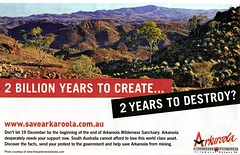
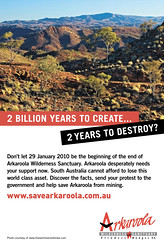 The public submission deadline for comment on 'Seeking a Balance - Conservation and resource use in the Northern Flinders Ranges' has been deferred until January 29th, 2009
The public submission deadline for comment on 'Seeking a Balance - Conservation and resource use in the Northern Flinders Ranges' has been deferred until January 29th, 2009




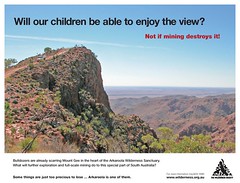
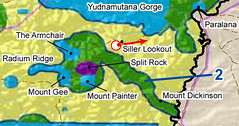

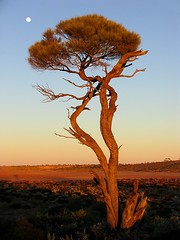
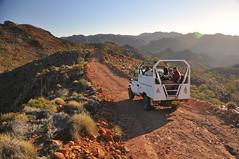
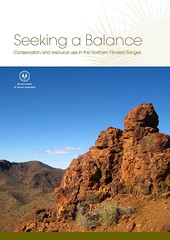
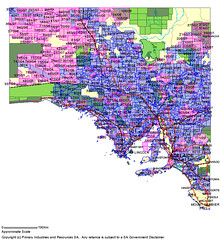
![link to the u[n]sa homepage](http://users.chariot.net.au/~greenh/blog/unknownsa_ublog-text.gif)


![link to the u[n]sa features page](http://users.chariot.net.au/~greenh/blog/features_ublog-text.gif)
![link to the u[n]sa kangaroo island feature image pages](http://farm2.static.flickr.com/1306/1187313059_93fdefd86b_o.jpg)
![link to the u[n]sa katarapko creek / murray river np feature image pages](http://farm2.static.flickr.com/1435/1181073355_b5c45f799d_o.jpg)


!['constellation' - wild country [national] set on flickr](http://farm1.static.flickr.com/155/415123844_3e6da621e5_s.jpg)

!['the bay serene' - the wild west [coast] set on flickr](http://farm1.static.flickr.com/121/312226516_606ac35455_s.jpg)








![u[n]sa journal -thanks for your time! u[n]sa journal - thanks for your time!](http://users.chariot.net.au/~greenh/blog/journal_ublog-text.gif)